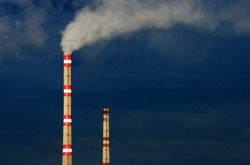 The Energy Information Administration (EIA) estimates that energy related carbon emissions declined 2.8% in 2008 from 2007 levels, the largest decline since 1982.
The Energy Information Administration (EIA) estimates that energy related carbon emissions declined 2.8% in 2008 from 2007 levels, the largest decline since 1982.
The large overall decline is attributed mainly to skyrocketing gas prices in the spring and summer, followed by a crashing economy that culminated in the fall. The Gross Domestic Product (GDP) inched up 1.1% last year with a concurrent decline in energy demand of 2.2%. The amount of energy required to produce one unit of GDP dropped 3.3%
Decline in carbon intensity
Carbon intensity refers to the amount of CO2 emitted per unit of GDP. In 2008 carbon intensity dropped by 3.8%. Carbon intensity in the United States has dropped 29.3% since 1990. The 3.8% decline last year is far greater than average decline of previous years.
Renewable help ease emissions from electricity generation
The expanding base of power generation from wind helped lead to a decline in emissions of 1% from the electric power sector, the nation’s largest emitter of CO2. Emissions from coal burning plants fell 1.1%.
Emissions monitoring by the EIA is broken down by sector, including transportation, residential, commercial, and industrial. For all these sectors emissions declined, with the exception of commercial, which includes offices, government buildings, schools, hospitals, and stores. Emissions for the commercial sector rose 0.5%.
Before 2008, the only years that saw declines in the transportation sector since 1990 were in 1991 (1.3%) and 2001 (1.2%). 2008 saw a plunge in transportation-related emissions of 5.2% due to a “flight from the pump” in response to record gas prices.
Not a reason to waver from emissions legislation
Even with the decline in emissions in 2008 due to a slumping economy, emissions are still 15.9% higher than they were in 1990. The EIA estimates that by 2030, global energy demand will increase some 44% with a rise in carbon emissions of 39% if “business as usual” consumption and demand patterns return with a recovering economy. Environmentalists and climate scientists warn Congressional leaders not to waiver from getting legislation passed to drive down carbon emissions and reverse the overall trend.
This [decline in emissions] isn’t a big shock given last year’s economic downturn,” Frank O’Donnell, head of Clean Air Watch, told the Washington Post. “The real issue going forward is how to make sure emissions go down as the economy starts growing again . . . . We don’t want a sick economy to be the solution to a sick planet.”
Sources and further reading
Reuters
Associated Press


